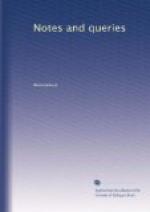I.F.M.
* * * * *
TRAVELLING IN ENGLAND.
Sir,—I beg to acknowledge the notice which two of your correspondents have taken of my query on this subject. At the same time I must say that the explanations which they offer appear to me to be quite unsatisfactory. I shall be happy to give my reasons for this, if you think it worth while; but, perhaps, if we wait a little, some other solution may be suggested.
For the sake of the inhabitants, I hope that your work is read at Colchester. Is there nobody there who could inform us at what time the London coach started a century ago? It seems clear that it arrived in the afternoon—but I will not at present trespass further on your columns. I am, &c.,
G.G.
* * * * *
MINOR NOTES.
Ancient Inscribed Alms Dish.
L.S.B. informs us that in the church of St. Paul, Norwich, is a brass dish, which has been gilt, and has this legend round it four times over:—“HER: I: LIFRID: GRECHº: WART."[4]
This seems to be another example of the inscription which was satisfactorily explained in No. 5. p. 73.
[Footnote 4: Blomefeld’s
Norfolk. Folio. 1739. Vol. ii. p.
803.]
* * * * *
The Bishop that burneth.
I do not think Major Moor is correct in his application of Tusser’s words, “the bishop that burneth,” to the lady-bird. Whether lady-birds are unwelcome guests in a dairy I know not, but certainly I never heard of their being accustomed to haunt such places. The true interpretation of Tusser’s words must, I think, be obtained by comparison with the following lines from his Five Hundred Points of Good Husbandry, quoted in Ellis’s Brand, iii. 207.:—
“Blesse Cisley (good mistress) that
bishop doth ban
For burning the milk of her cheese to
the pan.”
The reference here, as well as in the words quoted by Major Moor, is evidently to the proverb relating to burnt milk, broth, &c.—“the bishop has put his foot in it;” which is considered by Ellis to have had its origin in those times when bishops were much in the habit of burning heretics. He confirms this interpretation by the following curious passage from Tyndale’s Obedyence of a Crysten Man:—
“If the podech be burned to, or the meate ouer rosted, we saye the Byshope hath put his fote in the potte, or the Byshope hath playd the coke, because the Bishopes burn who they lust, and whosoeuer displeaseth them.”
I fear the origin of the appellation “Bishop Barnaby,” applied to the lady-bird in Suffolk, has yet to be sought.
D.S.
Iron Manufactures of Sussex.




